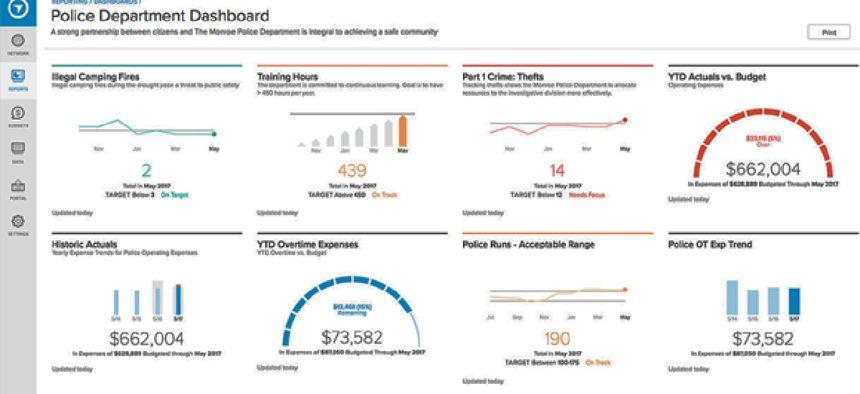Data-driven performance tracking for small governments


Connecting state and local government leaders
OpenGov's Performance Measures lets local officials organize and visualize data collected from individual departments.
Several years ago, the mayor of San Rafael, Calif., asked for tracking data on specific performance metrics beyond budget information. To deliver that material, Rebecca Woodbury, the city’s management analyst, used Microsoft Excel to compile statistics on things like crime and illicit massage parlors.
“I was using Excel spreadsheets and assembling these PDF documents that would be sent the mayor and the city council once a month,” Woodbury said. “It was just a pretty archaic way to share this information with the major. Frankly, it was a pretty time-consuming method to put it all together.”
Then OpenGov invited her to test Performance Measures, a new dashboarding tool released in October that’s part of the OpenGov Smart Government Cloud. Now, the city uploads its data to that cloud, and Woodbury creates custom dashboards that include printer-ready reports that she can provide to the mayor and city council in minutes.
Although OpenGov is known for its public-facing financial reporting tool, Performance Measures turns the magnifying glass inward, enabling governments to report on and understand their internal data, said Jonathan Brandon, the product marketing manager who helped build Performance Measures.
It’s common for departments to each have their own systems for collecting data, which complicates a city's ability to build a coherent big picture. For instance, the finance office might have its own accounting system, while the public-safety department's 311 system holds its data.
“They all have their own processes and systems for collecting data, but they’re not connected together," Brandon said. "What OpenGov does is allow them all to be merged together in the cloud so a parks and rec director can look at things like park attendance and maintenance requests or safety incidents, which could be coming from a 311 system, and then go down and look at revenues collected year-to-date based on transactions coming into the accounting system,” he said. With Performance Measures, decision-makers don't "have to address multiple systems and get analysts and coordinate people and get printed reports together just so they can understand a comprehensive view of their organization,” he said.
OpenGov designed the tool with smaller governments in mind. Those governments don’t always have the resources -- data analysts and overall technological savvy -- to use data, especially across disparate systems, for their strategic plans, Brandon said. “Over the years is ‘performance management’ has sort of become a dirty word, because unless you had those big data teams and had the technology, it became alienating,” he said.
Although she has not had a chance to share the new dashboards with city officials – the recent wildfires in that region took precedence – Woodbury said she’s close to being able to do so. In fact, the two weeks that the fires took her away from her usual work illustrate what work life is like as a small-government employee and why she expects Performance Measures to be so helpful.
“We’re a small city and a lot of our own bottlenecks come down to staffing and capacity to get something across the finish line,” Woodbury said. When it comes to delivering metrics, “it’s like 5 percent of me gets to work on this," so the last few months she has been building the internal capacity -- identifying people across the city "who can own these datasets and upload so it doesn’t get bottlenecked with me.”
So far she has identified counterparts in the city’s police and fire departments and is working to train them to use the platform.
Woodbury's goal is to create a culture of data-driven decision-making in San Rafael. Without solid data, city leaders rely on anecdotal information to set policy.
“The anecdotal and community input is an extremely important piece to the puzzle, but it’s a piece of the puzzle," she said. "The data is also a crucial piece.”




